Jack Moody
Inducted into the NHTA Hall of Fame in 2003.

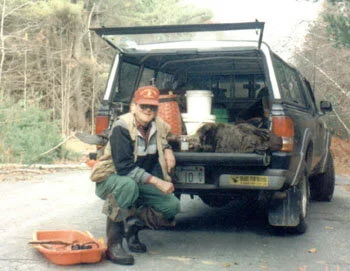
Seven Generations of Trappers: As told by Mel Liston
Sometime back in the early 1800s there was a trapper by the name of Moses H Moody practicing his craft round about Sutton NH. Moses was the first trapper in a continuous line of trappers up to this day and going strong into the future. Moses was the great granddad to Jack Moody the main character in this article.
Moses’ son, Albert A Moody trapped along with his father in Sutton. In 1889 Albert had a son, Arden C Moody who would also become a trapper. From a very tender age, Arden would tag along, gaining the skills required for his lifetime of trapping. Approximately 1920 Albert purchased a farm in Henniker, and moved his family to their new home.
Over the following years Albert and son Arden would expand their trapping territory throughout the Sutton/Henniker area. Arden would sire a son born July 25, 1926 in Henniker who would be named after the great-grandfather Moses H Moody. This Moses Moody would come to be called Jack by friends and family alike even though he would always sign his important papers as M. H. Moody. It was only natural that young Jack who was brought up on the farm and the fourth generation in a family of trappers would also take up the craft.
In those days it was a common practice of the rural farm family to include nuisance trapping of bothersome wildlife around the farm as a regular chore for young children. It was also a common practice for many farm and rural families to subsidize their difficult incomes by running a trapline in the fall and winter when furs are prime.
Generally these rural families did a lot of bartering and trading of services back and forth but cash was hard to come by. Fur trapping was a common mechanism utilized to raise hard cash necessary to pay their property tax. In those days so much of the success of a family operation depended upon a joint effort by the whole family. Often an experienced adult trapper would set out the trapline with young children checking the traps before and after school. It was through this joint effort that many young trappers gained their initial knowledge of the craft.
Jack started checking the traps for his dad around the farm for the nuisance animals and then additionally along the trapline in the fall when he was very young. By 10 years of age Jack was expected to set and check the trapline totally by himself. In those days the potential trapping income was critical, and therefore territory was guarded and methods or lure recipes were top-secret.
There were no books to read, no trapping manuals, no videos, and no experienced trappers willing to put on demonstrations exposing their methods and techniques for catching specific furbearers. Jack had the benefit of observing his father’s sets for a few years and was expected to learn by experience. That first season Jack utilized rusty traps covered over with duff and positioned beneath a dead chicken hanging from a tree. The very basics of trapping are to put your trap where an animal will naturally step (blind set), or use and attractant to draw the animal to your trap (baited set). The hanging bait set that was common for those times produced a red and also a gray fox for the young trapper, Jack Moody.
Throughout his youth Jack continued to trap the nuisance animals around the farm and harvest furbearers in the fall making his contribution to the families income. Like so many other rural farm boys the attack on Pearl Harbor ignited his national loyalty and Jack marched off to the recruiters office. The Marines made Jack wait until after his 17th birthday which he did, but shortly thereafter he set high school aside and enlisted.
Once boot camp was completed, Jack was shipped to the Pacific as part of the Sixth Marine Division and completed training on Guadalcanal. Jack’s 18th birthday passed without notice during the seven months he was stationed on Guadalcanal. Jack saw combat in the last battle of WW II at Okinawa. The military planners referred to the commencement of the engagement on April 1st 1945 as Love Day. For the folks back home it was April Fools’ Day. Many US Marines were killed or wounded in the effort to secure Okinawa. Jack was seriously wounded on June 6 when he was hit twice by machine gun fire. One bullet, which was nearly spent, hit his chest and the thin metal of his dog tag saved his life. The second bullet caught Jack in the leg producing a lifetime disabling injury.
After a long convalescence in military hospitals Jack was eventually discharged with a 70 percent disability. There have been continuing medical complications as a result of Jack’s wartime injuries and throughout the years he has undergone five operations. Ten years ago the military reclassified Jack as 100 percent disabled. While Jack was overseas, Doris Herzog a friend and neighbor of Jack’s sister started writing to him.
Doris never met Jack until he was lying in the hospital bed with a cast on his leg. Jack says it was seven months before Doris saw him in an upright position and clothed. Love grew so that Jack and Doris became husband and wife shortly after his discharge in 1946. Jack and another seriously wounded veteran from New Hampshire where the first two students in a specifically organized New England College Academy program designed to provide them the opportunity to gain their high school diplomas.
Jack and Doris lived on Long Island, New York the first seven years after the war before relocating the family to Concord where they have made their home. Jack had a long career in the insurance industry as an underwriter from which he retired in 1984. The main thing Jack wanted to do with his retirement was to get back into trapping, something he had sorely missed since his youth.
With full family support, Jack joined the NH Trappers Association and became a director in 1985. Jack would later become a lifetime member of the NHTA and be an active and participating director.
A lot of water had flowed over the dam since Jack trapped as a kid. The primitive traps and methods utilized by a self-taught kid in the 1930s would now be replaced with more modern equipment and a changed environment whereby many trappers were more willing to share their thoughts and techniques.
At this point in his life Jack was fortunate to find a friend and mentor in the now deceased Carl Bennett of Henniker. In Jack’s opinion Carl had the equivalent of a Ph.D. in trapping. Carl was a professional trapper, so good at the art and craft of trapping that he was able to support his family on trapping revenue alone. At one time Carl held the trapping rights to the entire White Mountain National Forest, which is now divided into 16 units and parceled out to different trappers through a lottery.
Carl purchased land in Henniker, which he paid for entirely with $20 bounties from bobcat. Jack gradually progressed into a combination mink, muskrat, beaver, fisher and fox trapper working mostly around wetlands. More than 25 percent of Jack’s fox catch was taken utilizing the spring hole set. I benefited greatly while watching Jack as he recently demonstrated the spring hole set to the trappers attending the NHTA spring meeting. Jack has a favorite method to catch beaver using a corral and dive stick, he also is a practitioner in the use of anthill dirt for freeze resistant canine foothold sets. Jack established a good relationship with his local conservation officer John E Whitmore who was the Lieutenant for NH Fish & Game District 4.
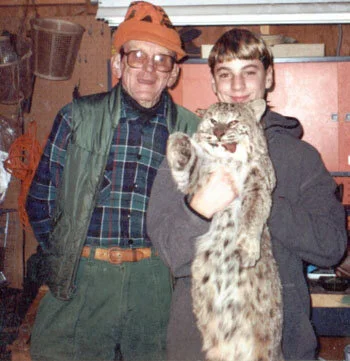
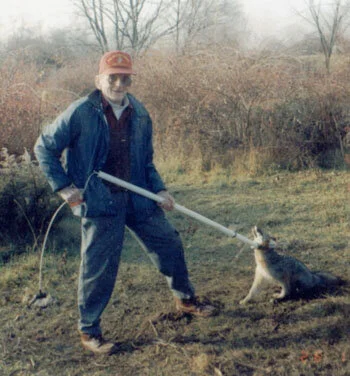
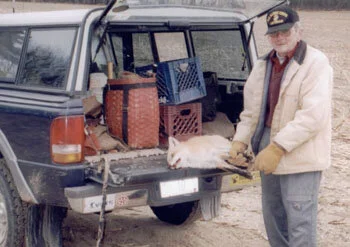
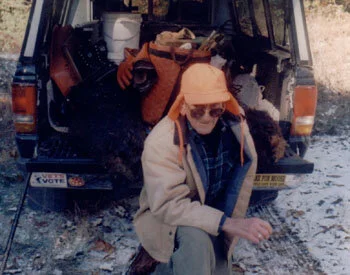
What Jack likes is the feeling that John is never looking for him but looking out after him. Jack has a lot of memories about trapping one of which is the time he caught three critters with one trap. A fox apparently scared two raccoons up a tree and then got caught in the foothold trap at the base. Jack harvested at all three animals. Once, Jack got his hand caught in a 220 Conibear trap and on another occasion got bit through the boot by a fisher. Three times his retirement trapline has produced a bobcat. Jack fondly remembers long trips to Wiscasset, Maine to buy supplies and sell his seasons catch to the well-known and universally liked trapper and fur buyer, Oscar Cronk.
Jack and Doris had six daughters but no sons. One of the daughters went along on the trapline quite regularly. There are two sixth generation grandsons who regularly trapped with Jack; Aaron Boisy (at the time, age 22 of Boscawen NH) and Greg Morgan (at the time, 17 years old from Concord NH). The seventh generation of great-grandsons is waiting for their turn on the trapline. Jack Klun, who lived in Delta Colorado was quite interested in trapping as were Jacob and Cape Mulsow of Meredith NH, and Justice Moody Anderson of Concord NH.
Jack Moody is a special person; he sacrificed for his country with dignity and paid a price more than most given the privilege to serve. Jack persisted in spite of considerable physical disability to produce a wonderful family and prosper. Although an easy-going, polite, and gentlemanly man there is an enduring strength that allowed this individual to overcome all the obstacles put in his way by fate.
Jack is the good sport who plays injured to win the game for his teammates. I have watched Jack attend many of our trapping events always with a walking stick or cane, sometimes a little shaky, but always with a smile and positive attitude. Many of us in our lifetimes will be tested by adversity; Jack Moody represents by shining example how the rest of us would like to hold up when so tested. Jack Moody has gained the admiration of a large family, many friends and neighbors, also the membership of the NH Trappers Association.
At our annual fall rendezvous in 2002 the NHTA inducted Jack Moody into the trappers Hall of Fame. Congratulations Jack on a life well done.
